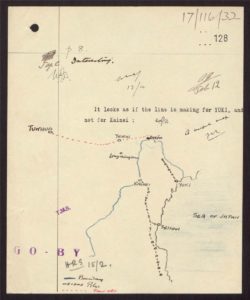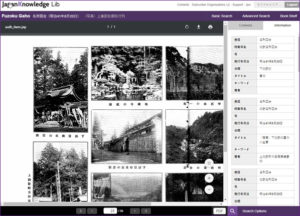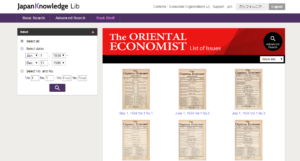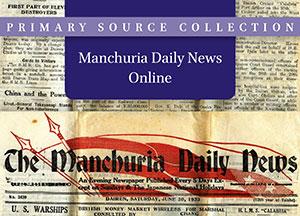Tag: Japan
Primary Sources: Resources on Japan
Another post where I am catching up on resources we’ve acquired or have been informed of in the past year or so.
Japan at War and Peace, 1930-1949: Records of the US State Department Classified Files, which includes
- Records of the Department of State Relating to the Internal Affairs of Japan, 1930-1939
- Records of the Department of State Relating to the Internal Affairs of Japan, 1940-1944
- Records of the Department of State Relating to the Internal Affairs of Japan, 1945-1949
Japanese Censorship Project
“The Library of Congress’ Asian Division has digitized its Japanese Censorship Collection, a unique online archive comprising more than 1,000 marked-up copies of government-censored monographs and galley proofs from the 1920s and 1930s in Japan. The collection, originally from the Home Ministry’s library, reveals traces of the otherwise-hidden censorship process of the Japanese government through marginal notes, stamps, penciled lines and commentary inscribed by the censors’ own hands.”
Fūzoku Gahō
This resource provides online access to a historical journal Fūzoku Gahō which was originally published in Tokyo between February 1889 and March 1916 in 518 issues with over 38,000 articles. It is said that Fūzoku Gahō was the first graphic magazine produced in Japan. The articles published on the journal cover a wide range of subjects, including social and cultural trends and conditions in the Edo, Meiji, and Taisho periods, customs, history, literature, things/objects and affairs, geography, war and disasters.
Note: There is a limit of 4 simultaneous users; if the access is denied, please try again later.
Primary Sources: Foreign Office Files for Japan, 1919-1952
 The Library has acquired the online archive Foreign Office Files for Japan, 1919-1952, which is sourced from Foreign Office Files from the UK National Archives. We currently have access to Modules I & II; Module III will be added in the near future.
The Library has acquired the online archive Foreign Office Files for Japan, 1919-1952, which is sourced from Foreign Office Files from the UK National Archives. We currently have access to Modules I & II; Module III will be added in the near future.
As described at the site, “these papers throw light on Anglo-Japanese ties in a time of shifting alliances. Documenting Japan’s journey to modernity, the files discuss a period in which the country took on an increasingly bold imperialist agenda. Strong relations following the signing of the Treaty of Versailles were tested then ultimately destroyed, and by December 1941, Japan and the United Kingdom were on opposing sides of the Second World War.
“These Foreign Office files cover British concerns over colonial-held territory in the Far East, as well as Japanese relations with China, Russia, Germany and the United States. Following surrender at the end of the Second World War, Japan was occupied by foreign forces for the first time in its history. The occupation resulted in disarmament, liberalisation and a new constitution as the country was transformed into a parliamentary democracy. Japan emerged once again as a player on the world stage.
“Consisting of diplomatic dispatches, correspondence, maps, summaries of events and diverse other material, this collection from the rich FO 371 and FO 262 series unites formerly restricted Japan-centric documents, and is enhanced by the addition of a selection of FO 371 Western and American Department and Far Eastern sub papers.”
Primary Sources: Fūzoku Gahō
 Description from the California Digital Library: “This resource provides online access to a historical journal Fūzoku Gahō which was originally published in Tokyo between February 1889 and March 1916 in 518 issues with over 38,000 articles. It is said that Fūzoku Gahō was the first graphic magazine produced in Japan. The articles published on the journal cover a wide range of subjects, including social and cultural trends and conditions in the Edo, Meiji, and Taisho periods, customs, history, literature, things/objects and affairs, geography, war and disasters.”
Description from the California Digital Library: “This resource provides online access to a historical journal Fūzoku Gahō which was originally published in Tokyo between February 1889 and March 1916 in 518 issues with over 38,000 articles. It is said that Fūzoku Gahō was the first graphic magazine produced in Japan. The articles published on the journal cover a wide range of subjects, including social and cultural trends and conditions in the Edo, Meiji, and Taisho periods, customs, history, literature, things/objects and affairs, geography, war and disasters.”
For more information about this resource, please check at: https://japanknowledge.com/ en/contents/fuzokugaho/index.html.
Primary Sources: Oriental Economist Digital Archive
 Here’s a description from the California Digital Library: “The Oriental Economist Digital Archive is an online version of the print journal Oriental Economist originally published monthly between 1934 and 1985 and weekly between January 1946 and August 1952 in Japan (in 874 volumes in 44,000 pages). It is one of the very few commercial journals in English with a focus on the Asian economy that lasted over 50 years from the pre-war period. While the Oriental Economist included some translations of articles published in the Japanese journal Tōyō Keizai Shinpō (1895-1960) /Shūkan Tōyō Keizai (1960-present), it also published its original contents.”
Here’s a description from the California Digital Library: “The Oriental Economist Digital Archive is an online version of the print journal Oriental Economist originally published monthly between 1934 and 1985 and weekly between January 1946 and August 1952 in Japan (in 874 volumes in 44,000 pages). It is one of the very few commercial journals in English with a focus on the Asian economy that lasted over 50 years from the pre-war period. While the Oriental Economist included some translations of articles published in the Japanese journal Tōyō Keizai Shinpō (1895-1960) /Shūkan Tōyō Keizai (1960-present), it also published its original contents.”
For more information about this resource, please check at: https://japanknowledge.com/en/ contents/orientaleconomist/index.html.
Primary Sources: Manchurian Daily News Online
 The Library has recently acquired the digital archive of the Manchurian Daily News and associated publications Manchuria Magazine, Manchuria Month, Contemporary Manchuria, and the Manchurian Information Bulletin. As described on the Brill website, this resource “offers scholars of Japan’s modern history an unparalleled inside view of Japan’s agenda in Manchuria and its plans for domination in Asia. Founded in 1908 in the wake of Japan’s victory in the war against Russia, the Manchuria Daily News set up in Dalian (Darien) at the headquarters of the South Manchuria Railway Company (Minami Manshū Tetsudō Kabushiki-gaisha) (SMR).
The Library has recently acquired the digital archive of the Manchurian Daily News and associated publications Manchuria Magazine, Manchuria Month, Contemporary Manchuria, and the Manchurian Information Bulletin. As described on the Brill website, this resource “offers scholars of Japan’s modern history an unparalleled inside view of Japan’s agenda in Manchuria and its plans for domination in Asia. Founded in 1908 in the wake of Japan’s victory in the war against Russia, the Manchuria Daily News set up in Dalian (Darien) at the headquarters of the South Manchuria Railway Company (Minami Manshū Tetsudō Kabushiki-gaisha) (SMR).
“Lavishly funded from Tokyo, and with the full resources of the SMR Research Department behind them, the Manchuria Daily News and the associated titles offered here constitute a formidable record of Japanese policy on Manchuria and the Manchoukuo project. From 1908-1940 this compact, feisty daily and its associated titles responded to the exigencies of the day, taking requests from a variety of official and often competing propaganda bureaux. In the Manchuria Daily News and in these associated publications, the SMR presented a powerful case for the Japanese leadership of Asia, after 1932 using Manchoukuo as a showcase for Japan’s technological, cultural and political advancement.”
Primary Sources: Japan Times Archives
Another recent acquisition of the Library is the digital Japan Times Archive, which provides access to the complete run (1897-2014) of this English-language daily published in Tokyo.
The archive contains a reported 490,000 pages of content, from 30,000 issues published over the 117-year history of the newspaper. The Japan Times was the first English-language newspaper in Japan to be put out by Japanese publishers and was for many years the only foreign-language newspaper in Japan. The paper maintained editorial independence for much of its history, though it was used as a propaganda tool for Imperial Japan during World War II. The paper went through occasional title changes, all of which are represented in the archive. The contents include:
The Japan Times (22 Mar 1897–1 Jan 1918)
The Japan Times & Mail (2 Apr 1918–10 Nov 1940)
The Japan Times & Advertiser / Japan Times Advertiser (11 Nov 1940–31 Dec 1942)
Nippon Times (1 Jan 1943–30 Jun 1956)
The Japan Times (1 Jul 1956–present)
Full text searching is enabled because the content has been OCR’d, but as with most digitized newspapers the OCR process is not error-free. You should be flexible in your searching and try variations of words. Read the help information to learn how to construct searches with *, +, and # operators.
Primary Sources: Meiji Japan
The American Edward Sylvester Morse traveled to Japan in 1877 searching for biological specimens and was welcomed by the Japanese Meiji government, which allowed him to establish a marine laboratory at Enoshima and offered him a position at the recently established Imperial University of Tokyo. While in Japan Morse acquired an interest in Japanese pottery and developed a significant collection that was deposited in the Boston Museum of Fine Arts. After returning to the United States in 1880, he became director of the Peabody Museum, a position that allowed him to spend additional time in Japan, where he produced ethnological works and assembled materials that documented the vanishing feudal Tokugawa civilization. His papers, deposited at the Phillips Library of the Peabody Museum have been digitized in Meiji Japan.
The collection of personal and professional papers includes diaries, correspondence, research files, drawings, lecture notes, publications, scrapbooks, and manuscripts, which document the numerous contributions made by Morse to the areas of malacology, zoology, ethnology, archeology, and art history. The digitized documents retain the same organizational structure as the original archive and there is a rudimentary search tool that allows for a search of finding aid labels and subject terms associated with the documents. Full-text searching is not available as the documents are primarily hand-written.
Trial: Japan Times Archive and the Japan Chronicle Weekly
We have trial access to the Japan Times Archive and the Japan Chronicle weekly through December 31, 2014.
These are both English resources on Japan.
Japan Times Coverage from Mar. 22, 1897 to 2013.
Japan Chronicle Coverage from 1919 to 1941.